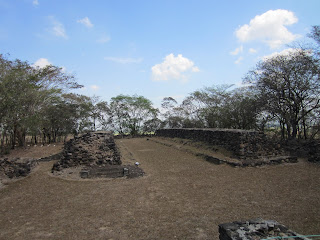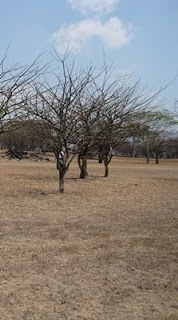Off the Beaten Path: Lots of Energy Here
We stopped at the entrance to pay our fees. "You are the guide, right? Salvadoran?" they asked me. I guess I have been to the Mayan ruins at Cihuatán enough times so they recognized me. "Almost the guide," I grinned, "but North American." They laughed. Salvadorans pay $1 to get in. We paid $3 each. The museum (with descriptions in English and Spanish), the well-marked and secure grounds and the nice restrooms are worth it.
Our team of physicians, nurses, pharmacists and teachers had been working hard for a week, caring for people during the Mission of Healing. A small group had stayed an extra day to learn a little bit more about Salvadoran history and culture. Cihuatán is out in the open country, offering a fresh view of the sky and the landscape. Early in the morning, before the sun beats down hard on the dry plain, you might catch birds roosting in the trees or small animals scurrying in the dry leaves. We were welcomed by a small group of vultures, who were hopping from ground to limb until our footsteps caused them to take flight.
 We walked along the trail marked by white painted rocks. The temples. The outer wall. The ball courts. We chatted about the stories we had read in the museum and imagined the people coming in from the surrounding fields on a Saturday afternoon to watch their teams from the high stone walls beside the field. We walked through the field. "Lots of energy here," one woman stated.
We walked along the trail marked by white painted rocks. The temples. The outer wall. The ball courts. We chatted about the stories we had read in the museum and imagined the people coming in from the surrounding fields on a Saturday afternoon to watch their teams from the high stone walls beside the field. We walked through the field. "Lots of energy here," one woman stated.

Just outside the sauna (even back in the day the athletes had good treatment for their injuries) stands a tall, tall tree. "Luis," we asked our friend and driver, "what kind of tree is this?" "Ceiba," he said. "It is a sacred tree for the Mayans. When it is young, it has these spikes. When it is older, the trunk is smooth. It grows tall and straight. The canopy reaches up to the heavens. The roots reach down to the underworld. The trunk represents our current life here on the earth. It is the national tree of Guatemala."
We walked along the one segment of the trail which is in the shade, beneath a grove of trees which stand along a ridge. Across the small valley and along the next rise, the excavation tents which had been present during my last visit were gone. Small sections of rock formations stood out next to the smoother hillside. Cihuatán is still rich with undiscovered structures and artifacts, and it makes good sense to visit this site prior to visiting the Guzman Museum of Anthropology in San Salvador. As we walked through the grove, we noticed the random piles of basalt rock. The last time I was here, I was told of the battles which took place here during the Civil War. Guerrilla fighters hid among the trees, and the rocks were scavenged to create shelters. Lots of energy here too.
We climbed the stairs up the mound to the main temple site. The stairs were built with money from the US. "Our planes bombed the heck out of this place and then we built some stairs," commented one of the doctors. The view from the top was not as clear as sometimes. The fires from burning cane fields shrouded the vista with gray smokey haze. Yet to survey the land which was once home to a bustling Mayan community from this vantage point is always impressive.
We descended and walked past the morra trees and the temple of the wind. I like to study the morra trees on this walk, and discovered a very still and camouflaged bird. As the group exited the site, Luis stopped to take a photo. "Look," he said, "a torogoz." This is the Salvadoran national bird. It was well hidden among tree branches, but the distinctive tail feathers stood out well enough to be seen. Some day I will come back with time just to sit at Cihuatán, to listen and to watch, and to feel the energy of life which is in this place.
Another post of interest...
The Morro Tree
Our team of physicians, nurses, pharmacists and teachers had been working hard for a week, caring for people during the Mission of Healing. A small group had stayed an extra day to learn a little bit more about Salvadoran history and culture. Cihuatán is out in the open country, offering a fresh view of the sky and the landscape. Early in the morning, before the sun beats down hard on the dry plain, you might catch birds roosting in the trees or small animals scurrying in the dry leaves. We were welcomed by a small group of vultures, who were hopping from ground to limb until our footsteps caused them to take flight.
 We walked along the trail marked by white painted rocks. The temples. The outer wall. The ball courts. We chatted about the stories we had read in the museum and imagined the people coming in from the surrounding fields on a Saturday afternoon to watch their teams from the high stone walls beside the field. We walked through the field. "Lots of energy here," one woman stated.
We walked along the trail marked by white painted rocks. The temples. The outer wall. The ball courts. We chatted about the stories we had read in the museum and imagined the people coming in from the surrounding fields on a Saturday afternoon to watch their teams from the high stone walls beside the field. We walked through the field. "Lots of energy here," one woman stated.
Just outside the sauna (even back in the day the athletes had good treatment for their injuries) stands a tall, tall tree. "Luis," we asked our friend and driver, "what kind of tree is this?" "Ceiba," he said. "It is a sacred tree for the Mayans. When it is young, it has these spikes. When it is older, the trunk is smooth. It grows tall and straight. The canopy reaches up to the heavens. The roots reach down to the underworld. The trunk represents our current life here on the earth. It is the national tree of Guatemala."
We walked along the one segment of the trail which is in the shade, beneath a grove of trees which stand along a ridge. Across the small valley and along the next rise, the excavation tents which had been present during my last visit were gone. Small sections of rock formations stood out next to the smoother hillside. Cihuatán is still rich with undiscovered structures and artifacts, and it makes good sense to visit this site prior to visiting the Guzman Museum of Anthropology in San Salvador. As we walked through the grove, we noticed the random piles of basalt rock. The last time I was here, I was told of the battles which took place here during the Civil War. Guerrilla fighters hid among the trees, and the rocks were scavenged to create shelters. Lots of energy here too.
We descended and walked past the morra trees and the temple of the wind. I like to study the morra trees on this walk, and discovered a very still and camouflaged bird. As the group exited the site, Luis stopped to take a photo. "Look," he said, "a torogoz." This is the Salvadoran national bird. It was well hidden among tree branches, but the distinctive tail feathers stood out well enough to be seen. Some day I will come back with time just to sit at Cihuatán, to listen and to watch, and to feel the energy of life which is in this place.
Another post of interest...
The Morro Tree




nice we used to have a torogoz that would come in to the back yard in our barrio{juan pablo and above constitucion} and get some bread we would get for the chias, I have a few fotos myself, very cool to see them in the wild
ReplyDelete